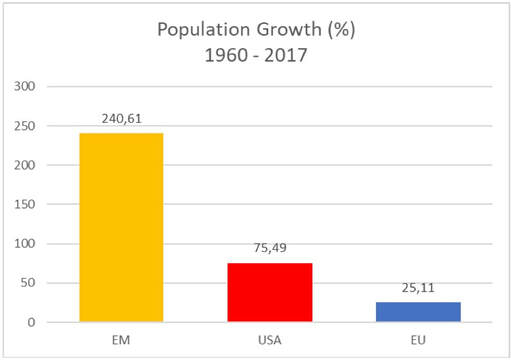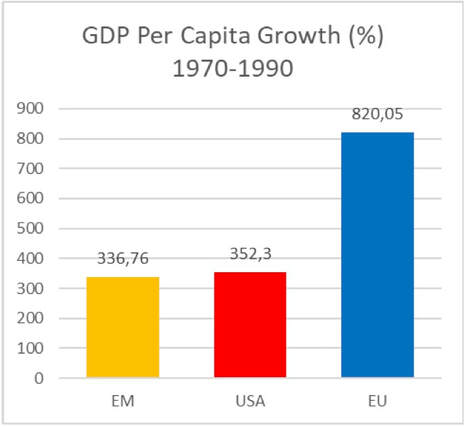GDP by definition “measures the monetary value of final goods and services […] produced in a given period of time” (IMF). Production derives from different inputs, mainly labour (i.e. people, both workers and entrepreneurs) and capital. Consequently, the more available these factors are, the more GDP is set for growth.
Gross Domestic Product per Capita in absolute terms (expressed in dollars) allows us to have an idea of the cost of labour in each country. Emerging countries, which are now offering competitive salaries, and for this reason are attracting massive foreign investments, are growing the most. Likewise, countries with a higher cost of labour (among which USA and some European countries) are more likely to experience capital outflows and weaker growth.
Moreover, labour is directly influenced by each country’s demographic characteristics, while today’s globalized economy acts as a catalyst through “Labour Market Arbitrage” (the possibility to easily outsource production where it is less expensive). Clearly more population translates into more workers, which leads to lower salaries, therefore stimulating production.
As we can see from the metrics analyzed below, European growth in productivity could be set to underperform the rest of the world, since the trends which contributed to its growth in the last decades are now reversing.
Gross Domestic Product per Capita in absolute terms (expressed in dollars) allows us to have an idea of the cost of labour in each country. Emerging countries, which are now offering competitive salaries, and for this reason are attracting massive foreign investments, are growing the most. Likewise, countries with a higher cost of labour (among which USA and some European countries) are more likely to experience capital outflows and weaker growth.
Moreover, labour is directly influenced by each country’s demographic characteristics, while today’s globalized economy acts as a catalyst through “Labour Market Arbitrage” (the possibility to easily outsource production where it is less expensive). Clearly more population translates into more workers, which leads to lower salaries, therefore stimulating production.
As we can see from the metrics analyzed below, European growth in productivity could be set to underperform the rest of the world, since the trends which contributed to its growth in the last decades are now reversing.
POPULATION GROWTH AND BIRTH RATE
On the long-term European population grows much more slowly than in the US and in emerging countries, and it has the lowest birth rate. Europe and the United States have been experiencing the same negative birth rate trend since the end of the 60s. The after WWII baby boom was surely one of the reasons for the strong rise in productivity and GDP per Capita. Today’s birth rate per 1000 is 12.4 for United States, and a meagre 10 in Europe (representing a fall of more than 50% from the 1960 peak for both regions). Emerging countries are showing heterogeneous trends, but their population is anyhow growing faster than the European one.
On the long-term European population grows much more slowly than in the US and in emerging countries, and it has the lowest birth rate. Europe and the United States have been experiencing the same negative birth rate trend since the end of the 60s. The after WWII baby boom was surely one of the reasons for the strong rise in productivity and GDP per Capita. Today’s birth rate per 1000 is 12.4 for United States, and a meagre 10 in Europe (representing a fall of more than 50% from the 1960 peak for both regions). Emerging countries are showing heterogeneous trends, but their population is anyhow growing faster than the European one.
AVERAGE AGE OF POPULATION
Europe also shows an above-average age of population, which directly leads to less workers, higher wages, and slower growth. Here again, it is experiencing a negative trend compared to the second half of the 20th Century, and due to the lower birth rate, the outlook for the next decades is worse than for the rest of the world (except for Japan). United States are facing the same problem, but population is aging at a slower pace.
Surprisingly, some developing countries are also experiencing an aging population, while others (such as India) have a very young one. But in these cases, the above-average population growth can offset this negative trend.
Europe also shows an above-average age of population, which directly leads to less workers, higher wages, and slower growth. Here again, it is experiencing a negative trend compared to the second half of the 20th Century, and due to the lower birth rate, the outlook for the next decades is worse than for the rest of the world (except for Japan). United States are facing the same problem, but population is aging at a slower pace.
Surprisingly, some developing countries are also experiencing an aging population, while others (such as India) have a very young one. But in these cases, the above-average population growth can offset this negative trend.
AVERAGE WORKING HOURS
Another way to consider productivity is as the product of the number of workers multiplied by output per worker. It is easy to understand how the output per worker is directly influenced by the number of hours worked (which are a result of both cultural factors and the degree of labour market rigidity). While according to OECD and Statista data, emerging countries tend to work the hardest (China stands out with 46 hours per week), United States is ranked in the middle (about 34.3) and European countries occupy the lower half (except for Greece, with an average of 39.1 hours per week).
However, Europe shows on average a high level of output thanks to efficiency of processes and machinery. This has allowed some strong economies (such as Germany or Luxembourg) to stay competitive. But in the long-run, due to labour market arbitrage, entrepreneurial resources and capital inflows to cheap labour countries, this advantage could deteriorate.
Another way to consider productivity is as the product of the number of workers multiplied by output per worker. It is easy to understand how the output per worker is directly influenced by the number of hours worked (which are a result of both cultural factors and the degree of labour market rigidity). While according to OECD and Statista data, emerging countries tend to work the hardest (China stands out with 46 hours per week), United States is ranked in the middle (about 34.3) and European countries occupy the lower half (except for Greece, with an average of 39.1 hours per week).
However, Europe shows on average a high level of output thanks to efficiency of processes and machinery. This has allowed some strong economies (such as Germany or Luxembourg) to stay competitive. But in the long-run, due to labour market arbitrage, entrepreneurial resources and capital inflows to cheap labour countries, this advantage could deteriorate.
CONCLUSION
In the last two decades (precisely from 1997 to 2017) the so called “Emerging Countries” (here we considered China, India, Mexico, Argentina and Thailand) have grown the most. China has experienced a tremendous +1140% in GDP per Capita, and the other emerging markets that we considered have outperformed developed countries. USA has experienced a decent growth as well (almost +99%), while the average of the Western European countries considered has been a relatively low +63.34%.
But from WWII to the 1990s (especially through the two-decade period from 1970 to 1990) the performance of these countries was very different. The same European countries continuously outperformed emerging markets and the USA, with a stronger GDP per capita growth.
In the last two decades (precisely from 1997 to 2017) the so called “Emerging Countries” (here we considered China, India, Mexico, Argentina and Thailand) have grown the most. China has experienced a tremendous +1140% in GDP per Capita, and the other emerging markets that we considered have outperformed developed countries. USA has experienced a decent growth as well (almost +99%), while the average of the Western European countries considered has been a relatively low +63.34%.
But from WWII to the 1990s (especially through the two-decade period from 1970 to 1990) the performance of these countries was very different. The same European countries continuously outperformed emerging markets and the USA, with a stronger GDP per capita growth.
Many factors contribute to each country’s productivity growth, some of which are difficult to analyze and forecast. However some parameters tend to have a direct and noticeable effect on GDP. Along with the level of indebtedness, economic policies, capital flows, etc, demographic trends can deeply impact long-term growth.
Most of the demographic tendencies which contributed to the European expansion from Post-World War II to the 1990s reversed, and are probably setting for EU underperformance throughout the next years. For the same reasons, emerging countries may overperform the rest of the world, and even the USA could lose their position of world’s largest economy in favor of China.
Remogiulio Cavuto
Most of the demographic tendencies which contributed to the European expansion from Post-World War II to the 1990s reversed, and are probably setting for EU underperformance throughout the next years. For the same reasons, emerging countries may overperform the rest of the world, and even the USA could lose their position of world’s largest economy in favor of China.
Remogiulio Cavuto





